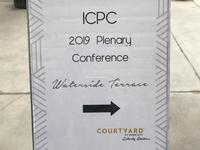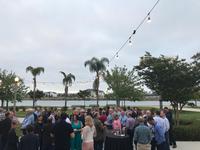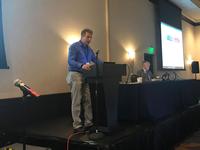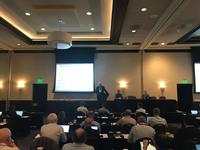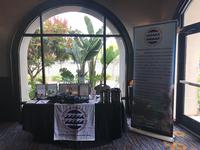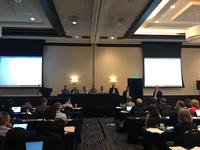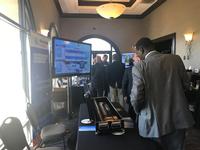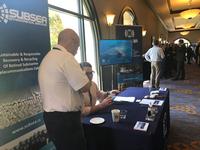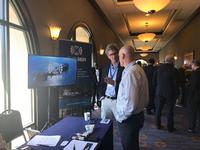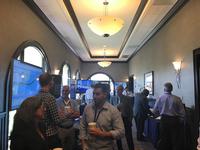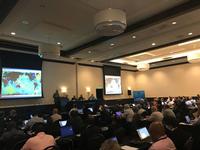Day 3: Thursday, 16 May
Protection of marine cultural resources
In a moving presentation, David Alberg from the National Oceanic and Atmospheric Administration (NOAA) presented an invited paper on “Sharing information and ideas prior to regulations being proposed.” The USS Monitor was commissioned, built and lost during the American Civil War, and her wreck lies off Cape Hatteras, North Carolina. The Monitor National Marine Sanctuary was subsequently designated to protect that cultural heritage—one of the most famous shipwrecks in US maritime history. In addition, there are many similar WWII wreck sites off North Carolina. To protect all these sites, NOAA plans to significantly extend the Monitor National Marine Sanctuary. Two main regulations would apply to this sanctuary: no removal of material or damage would be permitted, and trade in artefacts from the site would be prohibited. No specific impact on future cables is expected: new cables would not be excluded from the sanctuary, and existing federal regulations would cover the protection of these cultural resources.
Protection of marine natural resources
Carlos Orozco of Energia Integral Andina S.A. spoke on “Saving the coral reefs: A successful research experience implemented in area of a Submarine Cable Project.” The 830km SAIT submarine cable links the Columbia mainland (Tolu cable station) to the Island of San Andrés in the Caribbean Sea, having a maximum water depth of 3600m. Carlos described the coral species present in the archipelago, and the techniques which were used to collect samples of the coral and to grow then in nurseries over a period of 18 months, before transplanting them back to the cable installation site. Good news - after 10 years of monitoring, the cable has been completely covered by marine life, including those delicate corals.
Recourse after cable damage
LeRoy Lambert of Charles Taylor P&I Management (Americas), Inc. delivered an invited paper on “Cable Damage Claims against Vessel Owners,” which described the liabilities of ship owners when cables are damaged as a result of ship activities. Three examples of cases involving cable damage were provided, and key takeaways for cable owners and cable layers were summarised. If a cable is where it should be, and it is known to be there, then losses arising from damage by an oceangoing vessel are likely to be recoverable.
Risk management
Jenna Rennie of White and Case LLP spoke on “Managing Contractual Risk in Exclusive Economic Zones and Continental Shelves Regulated by Coastal States.” Jenna provided a high-level review of the current legal debate, presenting a list of states which implement regulations in the EEZ, arguably contrary to UNCLOS. She further offered practical tips to reduce delay to works caused by permitting and regulation by coastal states.
Coexistence of offshore energy and subsea telecoms
Denise Toombs from AECOM spoke on “US Offshore Wind Development and Subsea Fibre Hotspots: Managing the Intersection of Two Growing Markets.” The US Atlantic coast is seeing developments by both renewables and telecom cable sector and there are also plans for offshore energy off California and Hawaii. The presentation highlights the commonality between the sectors of some of the technical studies required, and other opportunities for information sharing such as fishing liaison and environmental mitigation measures.
Acts of terrorism on cables
The winner of the Rhodes Academy Submarine Cables Writing Award 2018, Ms Xuexia Liao of Peking University Law School,who spoke on the “Protection of Submarine Cables against Acts of Terrorism.” She elaborated on a key issue, namely on what basis coastal states can exercise jurisdiction over foreign terrorists attacking cables beyond its territorial waters. While UNCLOS requires that member states criminalise acts of damage to cables, this is not uniformly implemented (and penalties are generally low). Xuexia suggested that national counter-terrorism legislation rather than UNCLOS is the more appropriate legal instrument to establish jurisdiction over terrorist attacks. Xuexia graciously thanked the ICPC for its ongoing support to young law scholars.
Subsea applications of artificial intelligence
Richard Norris of Ciena introduced “The Adaptive Submarine Network,” describing the application of machine learning and artificial intelligence to submarine networks. Multiple optical transmission parameters can be accessed by open APIs and then stored and processed in the cloud. This allows network adaptations (for example as a reaction to network degradation, predicted failures, or to dynamic traffic demand) can be proactively performed within operator-defined policies.
Stéphane Alain Riou of SINAY spoke on the topic of “New developments of Artificial Intelligence and Big Data for cable security and protection, MSP and offshore windfarms.” Stéphane described the complex variety of maritime data available, the benefits of using AI to find relationships between these data sets, and potential applications to fleet management, environmental monitoring, risk studies, predictive maintenance and business intelligence.
“And the winner is . . .”
In the closing session of the ICPC plenary 2019, and in the glare of the world’s media, the ICPC’s General Manager Keith Schofield opened the golden envelope containing the results of the Membership vote for ICPC Officers and Executive Committee members:
- Malcolm Eccles of Basslink is elected to be ICPC Chairman—thank you for stepping forward, and we wish you all the best Malcolm!
- Graham Evans of EGS Survey steps down after three years of service as the ICPC Chairman to take up the post of Vice Chairman—thank you for your considerable time and effort, Graham. Keep up the good work in your new role!
- Appointees to the Executive Committee are: René d’Avezac (Fugro), Frédéric Exertier(Orange), Ron Rapp (SubCom), Andrés Figoli (Telxius), and Steve Dawe (Vodafone)
. . . in Spain. Stay tuned for further details!
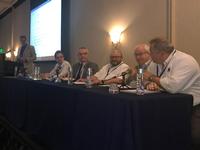
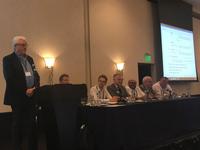
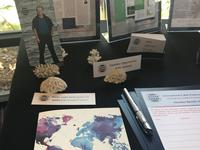
Day 2: Wednesday, 15 May
“Freedom at Last!”
The outgoing ICPC Marine Environmental Advisor (MEA), Prof. Lionel Carter, provided a review of his activities, not only over the past year, but over his 16 years in the role. Lionel’s parting gift was to propose a list of future projects which could be undertaken by the ICPC, which will certainly give the incoming MEA, Mike Clare, something to get his teeth into!
Just when Lionel thought that his work at the plenary was complete, the ICPC Chair, Graham Evans, stepped forward to present Lionel with a token of the ICPC’s huge esteem and gratitude for his years of passion, commitment, and relentless hard work. When the standing ovation had died down, (and many misty eyes around the auditorium had been wiped), Lionel responded with characteristic modesty and grace, thanking others for their support.
Many thanks to you Lionel – we wish you all the very best for the future!
Natural Marine Hazards
Mike Clare of the National Oceanography Centre Southampton (and incoming MEA) presented an invited paper titled “New direct measurements of powerful seafloor hazards provide insights for cable routing and design.” New tools and technologies are leading to new models of turbidity currents, which can inform cable design. Mike’s paper focused on the Bute Inlet in British Colombia, where 86 flows were observed over a period of around 6 months, and he summarised some key considerations for route planning.
Peter Talling of the University of Durham presented an invited paper titled “New technologies allow us to directly monitor and understand prodigious seabed flows that break submarine cables.” Peter described recent measurements of turbidity currents in three locations—Monterey Canyon, British Colombia, and Congo Canyon. Researchers can now directly measure the events that threaten cables, and they are beginning to get a sense of how flows are triggered and how they behave. The frequency and power of a flow exponentially decay with distance, potentially informing cable routing decisions in the vicinity of canyons.
Cables 101
Day 2 also featured a return of the popular lunchtime “Cables 101” session, intended for delegates who are new to the industry or wish to learn more. By contrast, the informative content was delivered by a small number of delegates whose combined experience in the industry well exceeds 100 years!
Cables 301
Jerry Brown of Hengtong presented “An overview of the armour wire protection of submarine cables.” The accelerated corrosion testing of double armour cable samples and individual armour wires was described. After a 25-year equivalent lifetime, there was a small degradation in wire strength, but the cable still conformed to its rated tensile strengths. Other components of the cable (PE insulation, copper conductor, fibres) were also within the rated range of values. Based on these results, system service life beyond 25 years appears to be feasible.
Distributed fibre sensing
Ian Walker of SDH Project Services spoke on “Protecting Submarine cables using Intelligent Optical Fibre Distributed Sensing.” Backscattered light from pulses launched into the fibre can provide a range of distributed measurements, such as temperature and vibration, with a resolution of 1m over a distance of 50km. Real time measurements on a Tampnet cable in the North Sea are planned to show the measurable effects of cable threats such as unexpected vessel movement and terrestrial earthworks.
Gary Waterworth, Alcatel Submarine Networks, followed up on this theme in his presentation on “Recent developments in threat and fault location in O/F cables.” External disturbances to the cable can be detected by Distributed Acoustic Sensing (DAS), for the monitoring of third-party activity and natural events in the environment. Modern low noise laser sources are improving the range of the DAS technique up to 140km. Trials performed on a Tampnet fibre in the North Sea were able to detect trawling activity at least 3km from the cable, and large vessels around 10km distant.
New cable routes
Paul Betts of CenturyLink presented “Innovative and Challenging Cable Routes,” which described the design of a cable route to build out a stub on the SAC cable to land in Buenaventura, Colombia. Challenges such as local cultural concerns, river dredging, high tidal currents and difficult logistics were described. Paul’s presentation tells the story – over approximately 5 years – of the cable route design, survey and installation, with a focus on the marine installation and cable protection methods.
In his presentation “Achieving Operational Independence: Rethinking Global Network Architecture & Ownership,” Roy Hilliard of NJFX described a case study performed with a bank to minimise or even potentially eliminate costly network downtime. A range of infrastructure issues affect the US east coast, such as choke points and network overlap, so banks are starting to look for a different solution to the networks available from traditional carriers. Specifically, the bank in question is considering a new private coastal submarine cable system on the US east coast to provide unique paths, direct routes and operational independence.
Marine maintenance
Andy Palmer-Felgate, Edge Network Services, described “Hyperscale Mesh Networks and the Implications for Maintenance.” Andy outlined a number of issues facing the maintenance market and evaluated multiple alternative approaches to maintenance such as: short term charters on the spot market; modular repair spreads on a VOO; multi-role ships serving multiple markets, and larger maintenance zones. While there will be a continued demand for dedicated repair vessels with skilled crews, especially in high risk areas, internet content providers would generally like to see continued innovation in this area.
Marine techniques
Steve Dawe of Vodafone presented “A Review of Best Practice for Power Cable Crossings with Telecommunications Cables,” a study inspired by planned power cables off Germany with seabed separations as low as 100m. This means that multiple power cables could cross a telecom cable over a very short length. The presentation described the traditional design of cable crossings and the modelling electromagnetic interference between cables. A new crossing design was proposed, in which the telecom cable would be cut either side of the crossing and the repaired cable re-laid on top of the power cable.
Dr Gabriela Dan Unterseh of Fugro GeoConsulting presented a paper on “Seismic Refraction and Geotechnical Data Integration for Cable Burial Assessment.” Tools for cable burial assessment developed in the 2000s (CPT and marine seismic refraction) have subsequently been improved and adopted in offshore energy projects. This paper describes a burial assessment project for French offshore windfarms in the English Channel. Refraction results were used to determine soil lithology and layering. After integration of geophysical and geotechnical data, fishing, shipping and anchoring threats were determined, allowing the target burial depth (and burial methods) to be optimised. Results were confirmed by in-situ trenching trials.
Submarine cable law
Christophe Bondy of Cooley LLP described “The Protection of Submarine Cable Enterprises under International Investment Law.” There are around 3,500 global investment treaties, which are policed by a branch of the UN. With such a treaty in place, international investment law can be used to seek redress against a coastal state if it behaves in a discriminatory and/or arbitrary way against an offshore investor. Rather than directly take action against the coastal states, an offshore investor’s claim can be heard by a neutral international tribunal, which can make a direct award of compensation. One potential example could be when negotiating cable landings, a coastal state favours a national investor vs. an international one.
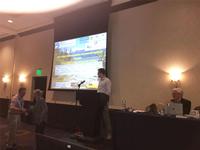


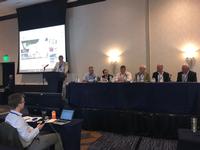
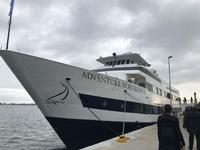
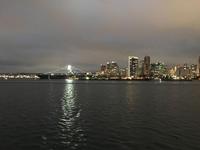

Day 1: Tuesday, 14 May
Welcome ICPC Members to the 2019 Plenary Meeting. We look forward to an exciting event as we gather together in San Diego, California under the theme "Critical Infrastructure Across the Oceans – protecting submarine cables and the marine environment." Please watch this space for daily updates.
Introductions, Comings and Goings
In its 61st meeting, ICPC Chairman Graham Evans welcomed over 145 delegates to the well-attended 2019 ICPC Plenary in San Diego as he opened the proceedings to the largest Plenary meeting in the organisation’s history. Graham himself steps down as the Chairman at the end of this year’s Plenary after three years of his exemplary service in the role. He later duly welcomed Malcolm Eccles, who will take the reins as the new Chairman. We thank you greatly Graham and wish Malcolm all the best!
Highlighted in his speech, Graham Evans also paid a glowing tribute to Prof. Lionel Carter because this year’s Plenary will be his last as he will retire as the ICPC’s Marine Environmental Advisor (MEA). The delegates responded with a very warm, gracious and prolonged applause. Lionel’s huge and heartfelt contributions to the goals of the ICPC will be long-remembered and truly missed. Stepping into Lionel’s capacious shoes will be the newly appointed MEA, Dr Michael Clare. Michael has been graciously supported by Lionel during the handover period. Welcome aboard, Michael!
Renewable Energy
In the first presentation of the Plenary’s open session, the invited paper “US Continental Outer Shelf Renewable Energy” was delivered by Jennifer Miller from the Office of Renewable Energy Programs, Bureau of Ocean Energy Management (BOEM). Jennifer’s talk focused on the issues and opportunities presented by offshore wind energy. Aside from the three basic requirements for wind power (nearby market demand, a favourable subsea environment and . . . wind!) Jennifer also highlighted the need for leadership at a state level. On the northeast US coast, the first wind energy is set to come online in 2020, with plans for further offshore assets stretching out to 2027.
Later in the day, Kris Ohleth from Ørsted US Offshore Wind picked up the common themes in her presentation titled: “Co-existing with Offshore Wind: The expected outlook for US offshore wind development.” This presentation further developed ideas around stakeholder sensitivity to offshore wind, with a particular focus on the Block Island Wind Farm off Rhode Island (the only operational US wind farm to date). Kris emphasised that while BOEM will delineate the lease block areas, the export cable may well-cross multiple telecom cables.
Arising from the Q&A after each presentation, ICPC members expressed gratitude that renewable energy players in the region are evidently willing to engage early with other seabed users such as fishermen and cable owners.
Cable Repairs
In an invited paper, Nick Harrington of Edge Networks reported to the delegates in an “Update on the Analysis of Cable Repair Data covering 2008-2018 inclusive, ”building on previous years’ data. 197 reported cable repairs were carried out globally in 2018 (a reduction compared with 240 in 2017), despite an increase in the overall quantity of cable-kilometres in service over the same period. As in previous years, the incidence of faults in the High Seas is small (2%), with an approximately even split of the remaining faults between territorial waters and EEZs. Nick highlighted that telecom carriers in Malaysia have been successful in using cable fault data to lobby for the removal of cabotage laws for cable repairs—a truly welcome outcome which demonstrates the value of good data and diligent analysis.
Alex Gauntt of Irish Sea Contractors presented a paper titled: “Innovating subsea power cable repair process: Why Lift?” proposing a modular solution for power cable repair on the seabed. In this scheme, a breathable steel habitat is placed on the seabed to allow a dry cut-and-repair—down to 200m water depth. Alex’s video of the first commercial repair process using this structure was a particularly compelling viewing.
Security of Submarine Cable Connectivity
The ICPC’s sharpened focus on cable security matters was demonstrated in a session of personal reflections on ideas, opportunities and experiences on cable security. Useful distinctions were drawn between cable protection (the ICPC’s historical stock-in-trade) and cable security (which implies the presence of malicious human intent). Speakers from around the globe described: the creation of national submarine cable associations with shared interests; the correlation of marine survey and AIS data to attribute seabed scarring events to specific vessels; a proposal for the sharing of global cable fault data to inform route planning, and a strong assertion that complacency is the biggest obstacle to fighting vulnerabilities in cable systems.
Legal Update
Kent Bressie, ICPC’s International Cable Law Advisor (ICLA), provided an update of key legal developments. In deep seabed mining, the threat to submarine cables remains, despite ICPC activity and discussions. Threats are foreseen in both new exploration and exploitation areas and ICPC Members were urged to contact their governments to raise their concerns. Specifically, a recent filing for exploration in the western Pacific Ocean potentially overlaps three existing cable systems.
UN Observer Review
Alice Colarossi, the ICPC’s UN Observer Representative (UNOR), reported that the ICPC was formally approved to have consultative status to the UN ECOSOC (Economic and Social Council), and furthermore is applying for consultative status in the IMO.
Biodiversity Beyond National Jurisdiction (BBNJ)
This session brought together the considerable intellects of Kent (ICLA), Alice (UNOR) and Lionel (MEA) to summarise the challenges posed to our industry by the potential new UN legal instrument on Biodiversity Beyond National Jurisdiction (BBNJ). While some parties wish to extend the provisions of United Nations Convention for the Law of the Sea (UNCLOS) with more stringent environmental protections, the ICPC argues that peer-reviewed science suggests a different direction, and seeks to guide the BBNJ instrument: to recognise cables as a sustainable use of the oceans, with socio-economic benefits, and with minimal environmental impact. The UN aims to agree a BBNJ treaty in 2020, although some doubt exists as to whether this is achievable.
You Can’t Keep a Good Man Down
Towards the end of Day 1, Lionel Carter (MEA) gave a presentation on “Discovering the Deep Ocean – a long and successful collaboration between the cable industry and academia.” With characteristic modesty and humour, Lionel presented a history of the intersection between cables and science, ranging from early oceanographer Matthew Maury in 1856, to Charles Kao – the father of fibre optics - in the 1960s. Key milestones along the way included: the discovery of deep water organisms (despite a widespread belief that life could not exist in the deep ocean); the origins of GEBCO charts; the principles of ocean circulation; turbidity currents, and the (thankfully very limited) incidents of whale entanglements in cable repair bights.
Despite Lionel’s assertion that predictions about the future are problematic, he then bravely made a number of predictions about the future. These covered: (a) our future understanding of how the shallows connect with the deep ocean; (b) the role of cables as environmental sensors of hazards and change, and (c) the performance of the New Zealand team in the 2019 Rugby World Cup.
Stay tuned for Wednesday’s update!
